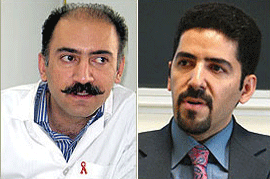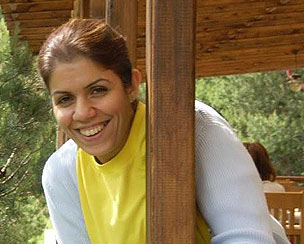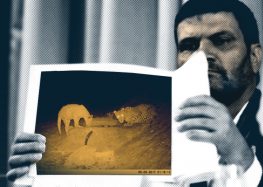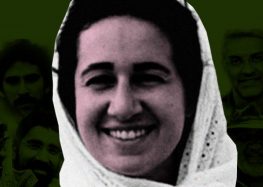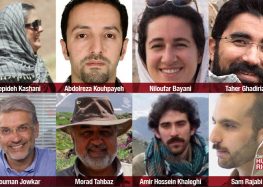Court Documents Show Obsession with Alleged US Intelligence Actions Led to Unfair Convictions
Download court rulings in Farsi
View English translation (text also copied below)
———————–———————–
Ruling in “Spying” Case Shows Utter lack of Evidence
(28 May 2009) The International Campaign for Human Rights in Iran has obtained copies of court rulings against four individuals prosecuted and sentenced to prison terms because they allegedly worked in cooperation with the United States government to instigate a “soft revolution.”
The four prosecuted individuals are Drs. Arash and Kamiar Alaei, Silva Harotonian, and Mohammad Ehsani. The Alaeis are world-renowned HIV/AIDS physicians, Harotonian is an administrator for the American NGO IREX, and Ehsani is a documentary filmmaker. Arash Alaei is serving a six-year sentence and the other three defendants are each serving three-year sentences.
The court documents clearly show that prosecutors failed to prove their guilt and indeed demonstrate that no convincing evidence was presented against them. The documents provide an unprecedented window into the arbitrary nature of rulings by judges in charge of evaluating alleged national security crimes.
“These documents prove the innocence of the defendants and show that their trial was unfair and based on a politically-motivated process. The head of the Judiciary should order an immediate investigation and release the defendants,” said Hadi Ghaemi, the Campaign‘s spokesperson.
The Judge’s ruling, unpublished previously, was not even provided to the families or lawyers of the defendants. The lower court’s ruling, dated 10 January 2009, is signed by Judge Salavati, presiding over Branch 15 of Tehran’s Revolutionary Court. The Appeals Court ruling, dated 18 March 2009, was issued by the director of Branch 54 of Tehran’s Appeals Court.
Two main features of the court ruling are that:
- The evidence against the four defendants considered by Judge Salavati consisted of: “Reports submitted by the Judicial-Legal Office of the Counter-Intelligence Office of the Intelligence Ministry of the Islamic Republic of Iran,” and “Explicit and implicit confessions of the defendants.”
- The sentencing is based on articles 500 and 508 of the Islamic Penal Code. Article 508 states that: “Any person or group who cooperates with an enemy government against the Islamic Republic of Iran, if not charged as a mohareb (waging an armed battle against the state) will be sentenced to one to ten years in prison.”
The four defendants were charged under the same laws under which Roxana Saberi was indicted, which allow for prosecutions based on cooperation with an “enemy government.” In the case of Roxana Saberi, the appeals court rejected the interpretation that the United States government can be considered an “enemy government” and threw out the charges based on this article of the law.
The Campaign called for the immediate release of these four individuals in light of the Appeals Court’s ruling in Saberi’s case.
Furthermore, the court documents demonstrate an utter lack of evidence against the defendants regarding cooperating with the U.S. government against the Islamic Republic of Iran.
“There cannot be two standards of justice that are selectively applied,” Ghaemi added. “This case should be referred to competent Judges, just as Saberi’s case was.”
The only evidence cited by Judge Salavati is based on a report by the Intelligence Ministry and “confessions,” which the defendants repudiated in the courtroom.
The so-called “confessions” cited in the court ruling mostly include preparations and planning for international seminars. There are no laws criminalizing such activities in Iran.
Inserted within the details of these “confessions” are indications that the defendants knew such activities were a cover for covert U.S. intelligence activities. However they rejected such claims during their trial.
According to the mother of Arash and Kamiar Alaei, they both denied their “confessions” that the interrogators produced in the court. In an interview with the Campaign, she said that, both in writing and verbally, Arash and Kamiar told the Judge that the “confessions” quoted on their behalf in their file were false.
According to the Iranian laws, false confessions, repudiated by defendants, have no validity and should not be used as a basis for prosecution and sentencing.
The Campaign has previously documented how Silva Harotonian was held in solitary confinement and forced to make false confessions.
The court ruling opens with a review of the judicial process (gardeshkar) that is far removed from judicial analysis and justifications. It is written in crude and disconnected logic that shows the Judge’s and the Intelligence Ministry’s analysis to reflect a profound ignorance of normal international professional exchanges and seminars.
The Judge writes in a polemical style, connecting any and all interactions with American institutions to a plot directed and controlled by American intelligence services. Without providing any evidence or corroborating documents, the Judge construes all cultural and educational exchanges with American institutions as a front for U.S. intelligence activities, without noting that the Iranian government had indeed encouraged and even participated in some of these events:
“The Dubai office [of the U.S. Consulate] worked with institutions such as the Aspen Institute, Asia Society, OSI, IHRD, CDC, NIC, ILB, and universities such as Harvard, John Hopkins, Maryland, Yale, New York, Stanford, San Francisco. Using the multi-million dollar budget allocated by the Congress for this purpose and under the cover of the State Department and the Institute of International Education (IIE), [these projects] were implemented, with the covert planning of American intelligence services, and thus the exchange program was put into action.”
The Judge’s ruling describes the activities of the defendants as a covert intelligence operation without providing any evidence. To the contrary, the defendants’ participation in exchange programs with their American colleagues was transparent, and the Iranian government was fully aware of them.
Silva Harotonian worked as an administrator for the American NGO IREX. The Iranian government had previously invited IREX officials to Iran to attend seminars. Paige Alexander, the Vice President of IREX, told the Campaign: “IREX had numerous academic programs with Iran over the years. IREX staff had been invited by the Iranian Government in 2003 to attend a tour with leading American university administrators to look at the university system and discuss ways to cooperate more closely. In 2004, IREX was invited back by the Ministry of Foreign Affairs to deliver a paper on Central Asia and related energy issues with the region. For this reason, as well as other promising overtures, IREX had no reason to believe the program Silva was working on would have been construed in any negative fashion by the authorities.”
Furthermore, Silva Harotonian had informed the Iranian authorities of her project. According to Alexander: “In the course of her work, Silva on her January 2008 trip, decided to contact the Department of Health. We understand she was advised to use the existing hospital and university contacts to let the program be known to the health professionals. Because this program was so small and short in duration, we were confident that Silva had received the best advice about how to proceed with the program’s implementation in cooperation with Iranian authorities.”
The basis of the allegations against the Alaei brothers revolves around their participation in a high-level medical conference funded by the US State Department and organized by the Aspen Institute in Washington DC from 28-30 November 2006. They also recruited a dozen top Iranian medical experts for the event, which was highly scientific. Its sessions included topics such as “Pediatric Oncology and Child Health,” and “Infectious Diseases, including HIV/AIDS and Tuberculosis.”
The Iranian government was fully aware of the program and its representatives attended some of the sessions. Iran’s Interest Section, its diplomatic representation in the United States, even held a dinner for the Iranian delegation during their stay in Washington D.C. It was provided with full details of the participation of Iranian physicians and researchers and the entire program was transparent.
“Iranian officials have repeatedly welcomed people-to-people exchanges between the two countries. How can they allow the imprisonment of innocent people whose activities took place in such a context and were completely transparent to the government? The top leadership should immediately ensure the release of these innocent victims of the Intelligence Ministry’s obsession with finding American spies,” Ghaemi said.
The lawyers for the four defendants have made an appeal to the Supreme Court to take up the case. The Campaign called on the Iranian Judiciary to immediately review the case and in light of the lower court and the subsequent appeals judges’ erratic legal opinion, which is in contradiction with interpretation of the law by Appeals Court judges in Roxana Saberi’s case, and, in view of the complete lack of evidence, to acquit the defendants.
The Court documents are blank under the section for Mohammad Ehsani. The Campaign has not been able to verify any information regarding Ehsani except that he is a documentary film maker who screened some of his works at a gallery in the United States. The Campaign is seriously concerned about lack of information regarding Ehsani and believes his mental and physical health could be in danger.
The Appeals Court ruling is a one page document that does not consider any details of the case. It rejects the appeals from the defendants as redundant arguments already presented in their earlier trial and restates the lower court’s ruling.
To see the original Persian copy of the lower court and the appeals court’s decision visit:
https://iranhumanrights.org/2009/05/courtrulings/
———————–———————–
Full text of the court ruling, translated by the International Campaign for Human Rights in Iran:
On 10 January 2009, Branch 15 of the Islamic Revolutionary Court in Tehran, which I preside over according to the ruling number 1/82/17126 dated 27 January 2004, issued by the respected head of the Judiciary, held its hearing for file case numbers D/T/10099/87, D/T/10096/87, D/T/10097/87, and D/T/10278/87. The purpose of this session was to consider charges against Arash Alaei, son of Sha’ban; Kamiar Alaei, son of Sha’ban; Silva Harotonian, daughter of Khachatoor; and Mohammad Ehsani, son of Majid. Thus, in accordance with the content of their files and having heard the last defense of the defendants and their lawyers, I declare the end of these proceedings and issue the court’s decision as follows.
Court’s Decision
With regards to the specific charges brought against:
1. Arash Alaei, son of Sha’ban; born in 1348(1969); with birth certificate number 14554; a medical doctor from Kermanshah who resides in Tehran; has no prior penal record; Moslem; Iranian citizen; detained on the following charges:
a. Actions against domestic security by way of cooperation with the government of the United States of America against the sacred Islamic Republic of Iran;
b. Possession of alcohol and possession of satellite equipment.
2. Kamiar Alaei, son of Sha’ban; born in 1353(1974) with birth certificate number 71; a medical doctor from Kermanshah who resides in Tehran; has no prior penal record, Muslim; Iranian citizen; detained on the following charges:
a. Actions against domestic security by way of cooperation with the government of the United States of America against the Islamic Republic of Iran.
3. Mohammad Ehsani, son of Majid; born in 1352(1973) with birth certificate number 14; Muslim; from Tabriz who resides in Tehran; has no prior penal record; Iranian citizen; filmmaker; detained on the following charges:
a. Actions against domestic security by way of cooperation with the government of the United States of America against the Islamic Republic of Iran;
b. Propaganda activities against public order against the Islamic Republic of Iran.
4. Silva Harotonian, daughter of Khachatoor; born in 1353(1974) with birth certificate number 1017; born in Tabriz; Iranian citizen; resident of Armenia; of Armenian religion; has no prior penal record; employee of the American organization IREX; detained on the following charges:
a. Actions against domestic security by way of cooperation with the government of the United States of America against the Islamic Republic of Iran.
The Process (Gardeshkar)
The effort to confront and oppose the Islamic Republic of Iran has been consistently a priority of United States national security doctrine during recent decades. Accordingly, various proposals have been made, including military confrontation by imposing a war, confiscation of property and assets (economic sanctions), destructive political propaganda and cultural invasion, supporting political opposition movements, fomenting terrorist and anti-regime groups, attempts to isolate [Iran] on regional and global stages, supporting ethnic movements to cause disintegration, assisting the distribution of harmful narcotics within Iran through eastern borders, attempts to divert the path of social movements with the goal of aligning them with movements to overthrow the state, and challenges of the nuclear program. All of the above are actions that despite much financial and human capital investments as well as propaganda attempts, have widely failed.
In recent years, United States military and intelligence organs, having failed both to confront Iran militarily as well as to achieve a change in the direction of the Iranian government and people through carrot and stick policies and military threats, have initiated a new policy. They have changed the direction of their hardline approach by implementing a policy of soft and gradual regime change. Two key points of this new policy are regime change and changing the behavior of the regime. [The U.S. government] attempts to attract and employ elements from non-governmental organizations (NGOs), journalists, bloggers, members of the intellectual and educated class, scientific leaders, social movements, and students by creating organic linkages. Such linkages aim to transfer and inject the necessary values to the body of the above mentioned groups and create a divergence between the values of the ruling class and those of the people. This divergence in values [between the society vs. the state] will eventually cause a rift between the state and the people and transfer sovereignty to the minority [who has captured] the majority [of public opinion] and causes the majority of the masses to believe in the values of a system to the liking of the United States, thus resulting in a surrender of sovereignty. At this stage , the political leadership will either surrender to the social pressure of the masses and their civil resistance or it will allow changes to its policies that will be to the liking of the American government. With the addition of tough economic sanctions, street riots, and if necessary with tactical and limited military strikes, the fall [of the state] will result.
After the failure of plans implemented by the Soros Foundation and the Open Society [Institute], the arrest of their representative inside the country (Kian Tajbakhsh) ,and [their failure] to reach their goal to bring about desired changes and overthrow the ruling system by using the popular potential to overcome limitations, American intelligence services planned an alternative project based on the concept of exchanges. As such, American elements coordinated with scientific and research centers in that country and invited certain well-known personalities to induce the impression of the necessity of exchanges between the United States and Iran.
According to the confessions of the defendants as well as judicial and intelligence investigations, the four stages of advancing covert American actions in the country [Iran] are:
1-Implementaion of the plan for a regional initiative by the Soros Foundation (OSI)
2-Implementing exchange programs
3-Public health diplomacy
4-Bilateral interactions ( travels and visits by Iranian and American citizens to each country)
It is necessary to note that preventative actions, confessions of the defendants, as well as an analysis of American intelligence policies reveal that the management, policy-making, planning, and organizing of these projects are carried out by American intelligence agencies. Other centers such as the State Department and [American] non-governmental organizations have the responsibility to provide cover and superficially coordinate [these projects] and make arrangements to persuade targeted persons to participate in such gatherings.
Aiming at these objectives, [American] intelligence stations in Turkey, Azerbaijan, Germany, England, and the UAE started their activities. The responsibility for the regional command was given to the Dubai office under the cover of the Special Office for Iranian Affairs. The Dubai office worked with institutions such as the Aspen Institute, Asia Society, OSI, IHRD, CDC, NIC, ILB, and universities such as Harvard, John Hopkins, Maryland, Yale, New York, Stanford, San Francisco. Using the multi-million dollar budget allocated by the Congress for this purpose and under the cover of the State Department and the Institute of International Education (IIE), [these projects] were implemented, with the covert planning of American intelligence services, and thus the exchange program was put into action. Ramin Agsari and Allen Eyre are among the American intelligence agents who played an important role in implementing these actions through the Dubai office. From another side, in the country of Armenia, the American organization IREX, as a cover, and with the management of Ms. Azita Zohrabian and its representative Silva Harotonian, the fourth defendant in this case, under the cover of scientific, public health, and cultural cooperation entered into action and took on another part of the project. These cover institutions planned and implemented their activities according to the following framework.
1- Determining subjects [of interest] (medical groups, lawyers, fashion designers, university faculty in the field of crisis management, clerics, artists, documentary-makers, photographers, women, etc ….)
2- Identifying and activating the heads of internal networks for choosing individuals (such as the defendants of this case)
3- Selection and confirming desired individuals for travel and training
4- Sending emails and invitation letters as a cover (issued by institutions and non-governmental organizations)
5- Holding justifying meetings and coordinating inside the country (because of lack of security and intelligence concerns around hospitals and medical clinics, these meetings were primarily held in such places)
6- Sending individuals to Dubai for briefings by intelligence officers (under the cover of the State Department)
7- Holding briefings, coordination, and issuing visas (outside the queue)
8- Sending subjects to the United States
9- Entrance to the U.S. and being welcomed by State Department Officials
10- Participation in training workshops
11- Receiving the core [of the program] and activities inside the country (according to a mushrooming network) and following security concerns and covert-activity methods
12- Starting the activities of the individuals within the masses and in lower and middle levels of the society. Implementing actions such as producing propaganda movies, opening websites and counterrevolutionary satellite channels abroad, penetrating scientific centers and universities, instigating ethnic , women’s and student movements, presenting an unacceptable atmosphere from inside the country, weakening religious and national beliefs, and defaming State and government officials.
Within these goals, defendants number 1 and 3 were among those responsible for the network and implementers. Defendant number 2 mainly was in charge of coordinating activities with the United States, and defendant number 4 was the representative of IREX in Armenia and active in Iran.
The term “Motekhasem” [enmity] is from the root word “Khasm” meaning “enemy.” In dictionaries it is defined as having enmity with one another. The term “Khasm” is also used in the sacred Qur’an (Sura 38, Ayah 64) meaning having enmity towards each other. In legal terminology, two sides of a legal argument are also called “Motekhasem,” while it is clear they are not engaged in armed conflict with each other. It is interesting to note the term “Jang” [war] does not necessarily mean an armed battle, as expressions such as “Cold War” which is the height of propaganda war between two countries, is well-known in international affairs. In the laws of the Islamic Republic of Iran, the legislature did not use the term “Enemy Government” to mean necessarily a government that is at war with Iran (part 6, article 11, The Armed Forces Penal Code) and the intention of the legislature, in using the phrase “enemy,” is not an entity that is at war with Iran. According to article 25 of the Armed Forces Penal Code, passed in 2003, enemy comprises groups and governments who are at war with the Islamic Republic of Iran, or intend to overthrow it, or whose activities are against national security.
Therefore under Iranian laws, referring to a foreign and enemy government is not necessarily a government that is engaged in armed conflict but is a government whose interactions with Iran are not friendly or impartial but are based on enmity.
Indeed, the great flag-bearer of the pure Islam of Mohammad, Imam Khomeini, said it so well: that today all our troubles stem from America, our number one enemy and the Great Satan.
Therefore, noting the reasons outlined below:
A- Reports submitted by the Judicial-Legal Office of the Counter-Intelligence Office of the Intelligence Ministry of the Islamic Republic of Iran;
B- Explicit and implicit confessions of the defendants including:
Defendant #1 (Arash Alaei)
h-1-1
h-1-4: The defendant’s confession to effective cooperation with the IREX organization in identifying and sending individuals to Armenia within the framework of exchange activities with cooperation of defendant #4 (Silva Harotonian) and Ms. Azita Zohrabian the manager of the said organization (pages 7,8,59 and 60 of volume 1 of the file)
h-1-7: The defendant’s confession to organizing and implementing exchange programs and sending individuals to the United States with the coordination of American officials and institutions (pages 21,25,28,29,33,61, and 62 of volume 1 of the file)
h-1-8: The defendant’s confession that he was aware and conscious that exchange activities are implemented by the U.S. State Department and intelligence services, and their budget is determined and paid by the Congress; and that introduced individuals for travel to the U.S. are evaluated by American officials and depending on their abilities to implement exchange programs are accepted (page 24, volume 1 of the file)
h-1-9: The defendant’s confession that because of the security nature of exchange programs he has taken steps to keep it from the public and has not publicized it in the media (page 25, Volume 1 of the case), and his confession that he has been aware that entering the exchange project had security implications and dangers (page 41 of the file)
h-1-10: The defendant’s confession that after entering the exchange program and holding training sessions in Washington, he became aware that the executive goal of these rounds was to make contacts with the Iranian people and government with the aim of changing state behavior according to the goals and interests of the United States
h-a-11: The defendant’s confession that in the exchange programs, individuals from various groups and levels were chosen such that after the implementing trainings, they would become active in the society along the goals of the project, and ultimately cause changes in the behavior of the Iranian government, in the interests of the United States, through creating social pressures.
h-1-16: …..
Defendant #2 (Kamran Alaei)
h-2-2: The defendant’s confession to cooperating and participating with defendant #1 (his brother) in executing the exchange programs
h-2-3: The defendant’s confession to identifying and introducing Iranian specialists for participation in directed seminars and exchange programs in coordination with IREX, ILB, and the Aspen Institute
h-2-4 The defendant’s confession to meeting and contacting essential elements with a program for soft and gradual overthrow of the Iranian state within the framework of exchange programs, including with those named as : Sana, Charis, Ramin Asgari, Ms. Jalilian under the cover of the U.S. State Department. Within these objectives, the defendant confessed that the ultimate and major aim of the exchange programs is to influence the participants to pressure the Iranian government to make changes desired by the United States
h-2-5 The defendant’s confession to participating in exchange activities with the cooperation of defendant #4, Ms. Silva Harotonian, and with coordination by the American organization IREX, and meeting the said defendant in the Hotel Jam-e Jam coffee shop and making email contact with the American organization IREX
h-2-6: ….
Defendant #3 (Mohamad Ehsani)
[This section is blank]
Defendant #4 ( Silva Harotonian)
0-4-1: The defendant’s confession that she has been the coordinator of exchange programs by the American organization IREX, resident in Armenia, and that she has been the representative of this organization in Iran (page 6, Vol. 4 of the file). Within this capacity, the defendant traveled three times from Armenia to Iran with the aim of identifying and sending individuals to the U.S. for the exchange program (pages 5,6,24, 25, Vol. 4)
0-4-2: The defendant’s confession to identifying, evaluating, and justifying individuals for IREX for sending to the U.S. with the cooperation of Arash Alaei (page 12, vol. 4)
0-4-3:The defendant’s confession to working with Ms. Azita Zohrabian, the director of IREX for supervising the case of a group of Iranians to travel in May 2008 for the purpose of visiting health professionals in the field of Mother and Child Care (page 6, vol. 4)
0-4-4: The defendant’s confession that the purpose of IREX was to disseminate American culture with the aim of promoting the government’s interests and that the goal of the U.S. government is to make desired changes in Iran in this way (pages 10-17, and 18, vol. 4)
0-4-5: The defendant’s confession that noting her illegal activities within the framework of the exchange program, she performed her activities in a concealed way based on the recommendation of Dr. Alaei. (page 9, vol. 4)
And according to other evidence their guilt is established, thus invoking articles 500, 508, and 702 of the Islamic Penal Code; and article 9 of the Law to Prevent Use of Satellite Receivers,
Defendant #1: Six years imprisonment
With regard to possession of alcoholic beverages, 4 years imprisonment is converted to 10 million Rials ($10,000) fine
Defendant #2: Three Years Imprisonment
Defendant #3: Three Years Imprisonment
Defendant #4 (Silva Harotonian) is sentenced to three years imprisonment.
However with regard to charges of membership in an armed opposition group for defendants # 3 and 4 (Mohammad Ehsani and Silva Harotonian), noting the content of their cases and their defense, because of lack of sufficient evidence and invoking article 37 of [not clear of which law], they are acquitted. The duration of their detention should be counted towards their sentence, based on the amendment to article 295 of the Criminal Procedures Code. This ruling may be appealed within 20 days in the appeals court.
Director of Branch 15
Salavati

